Do you have a question about the Rheem 90RS04EES Series and is the answer not in the manual?
Lists available upflow furnace models with their input and tonnage specifications.
Lists available downflow/horizontal furnace models with input and tonnage.
General warnings about following instructions to prevent fire, explosion, or injury.
Checklist items for ensuring proper gas supply and installation.
Checklist items for electrical connections and grounding.
Checklist items for furnace installation clearances.
Checklist items for measuring static pressure in ductwork.
Checklist items for condensate drain setup and protection.
Checklist items for direct and non-direct vent system installation.
Crucial warnings covering gas type, installation location, air supply, and operation.
Instructions on what to do if a gas leak is detected and leak testing methods.
Warnings about how duct leaks can draw pollutants into the living space.
Warnings related to mobile homes, garages, combustible floors, and lifting.
Warnings about improper venting, PVC cements, and air supply requirements.
Warnings regarding electrical connections, grounding, blower door switch, and temperature rise.
Details on furnace design certification by CSA and installation codes.
Schematic illustrating components of the upflow furnace model.
Schematic illustrating components of the downflow/horizontal furnace.
Explains how duct system balance affects efficiency and indoor air quality.
Details the risks associated with duct leaks and pollutant migration.
Instructions for inspecting furnace cartons and contents upon receipt.
Warning against using the furnace during construction with corrosive compounds.
Explicit warning against installing the furnace in a mobile home.
Specific safety requirements for installing furnaces in residential garages.
Requirements for auxiliary drain pans and heat tape in unconditioned spaces.
Details minimum clearances to combustibles for different furnace orientations.
Warnings about installing on combustible floors, carpet, or tile.
Guidelines for selecting furnace location based on duct and gas piping.
Explains airflow importance and warns against combustion products in return air.
Instructions for connecting ductwork to upflow furnaces.
Instructions for connecting ductwork to downflow furnaces.
Information on condensation, venting guidelines, and safety switches.
Requirements for PVC/CPVC venting systems in Canada.
Table listing pipe materials and their corresponding ASTM specifications.
Instructions and warnings for joining PVC pipes and fittings.
Warnings and requirements for air supply in non-direct installations.
Explains how corrosive atmospheres affect furnace components.
Details air supply requirements for furnaces in unconfined spaces.
Details air supply requirements for furnaces in confined spaces.
Important guidelines for installing non-direct vent systems.
Table showing maximum allowable vent pipe lengths based on elbows.
Requirements for vent terminal locations for non-direct systems.
Warnings about improper venting causing CO poisoning, explosion, or fire.
Details the combustion air system design for direct vent furnaces.
Guidelines for exhaust and combustion air terminations in direct vent systems.
Information and parts lists for alternate horizontal direct vent termination kits.
Details for the concentric vent kit for vertical/horizontal runs.
Illustrations showing typical vertical and horizontal vent kit installations.
Caution regarding condensate freezing and potential building damage.
Specifies minimum clearances for horizontal direct vent terminals.
Guidelines for proper vent termination location to avoid issues.
Instructions for connecting exhaust and combustion air pipes for upflow furnaces.
Instructions for connecting pipes for downflow/horizontal furnaces.
Cautions about draining outdoors and overflow prevention.
Details for setting up the condensate trap and drain for upflow models.
Details for condensate riser options and furnace shutdown.
Step-by-step instructions for converting the condensate trap for horizontal use.
Instructions for repositioning the condensate trap for right-side drainage.
Diagram and notes for connecting condensate trap for downflow units.
Warning about gas types, conversion kits, and proper installation.
Guidelines for installing gas piping according to local codes and utilities.
Details on natural and LP gas supply pressure requirements.
Description of the furnace's 24-volt gas valve and its operation.
Notes on LP gas properties and high altitude derating for Canadian installations.
Information on selecting and ordering furnace orifices for LP gas.
Alternate method for altitude deration in Canada using manifold pressure.
Procedure for measuring and adjusting supply gas pressure.
Procedure for measuring and adjusting manifold gas pressure.
Warnings regarding turning off power and proper grounding.
Warning not to disable the blower door safety switch.
Instructions on protecting electrical components and wiring polarity.
Information on thermostat compatibility and low voltage wiring.
Information on electronic air cleaners, humidifiers, and drain kits.
Requirements and considerations for twinning two furnaces.
Details on kits for converting furnaces for high altitude use.
Cautions and procedures for adjusting natural gas furnaces at high altitudes.
Tables for selecting natural gas orifices based on altitude and heat value.
Information on LP gas orifice selection and ordering.
Alternate method for altitude deration using manifold pressure for Canadian installations.
Step-by-step instructions for starting the furnace.
Instructions for safely shutting down the furnace.
Details the operational sequence of the electronic controls.
Procedure for checking furnace input to prevent over-firing.
Instructions for adjusting the furnace input rate to nameplate specifications.
Emphasizes the importance of proper duct system sizing for performance.
Procedure for checking airflow by measuring temperature rise.
Warning about adjusting temperature rise to the middle of the stated range.
Instructions for setting blower off delays using the control board jumpers.
Instructions and warnings for changing blower speed settings.
General warnings for qualified service personnel performing maintenance.
Table listing filter sizes and notes on installation and resizing.
Tips for customers to improve system operation and efficiency.
Recommendations for annual inspection of furnace components.
Warning about holes in vent pipes or heat exchangers causing toxic fumes.
Notes on checking possibilities and gas pressures before troubleshooting IFC.
Steps and conditions for initiating furnace start-up.
Details the furnace operational sequence for UT Electronic Controls.
Explanation of flame status LEDs and IFC blink codes for diagnostics.
| Model | 90RS04EES |
|---|---|
| Series | 90RS |
| Type | Gas Furnace |
| Fuel Type | Natural Gas |
| Efficiency Rating | 90% AFUE |
| Heating Capacity | 40, 000 BTU |
| Blower Motor | Variable Speed |
| Vent Type | Direct Vent |
| Input BTU | 40, 000 BTU |
| Warranty | 10-Year Parts, Limited Lifetime Heat Exchanger |
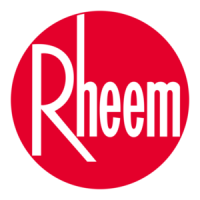

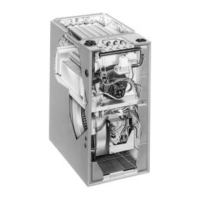

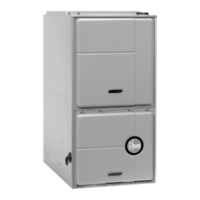
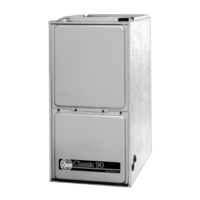
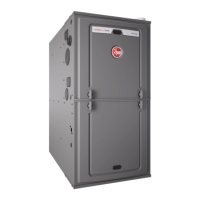
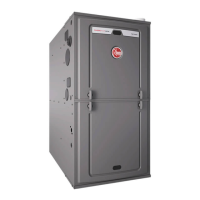

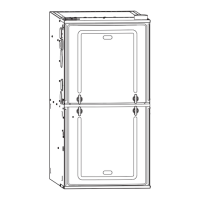
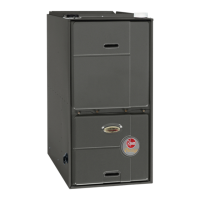
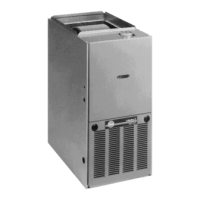
